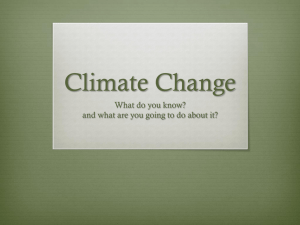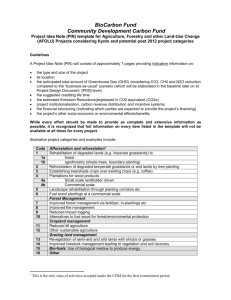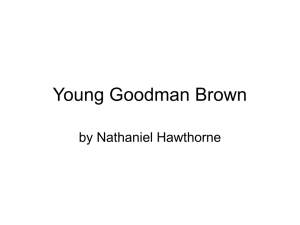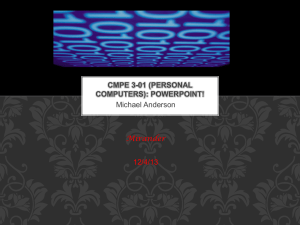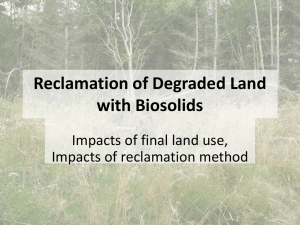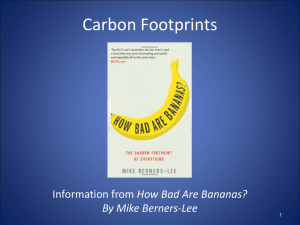Carbon Accounting on the Goodman Unit
advertisement
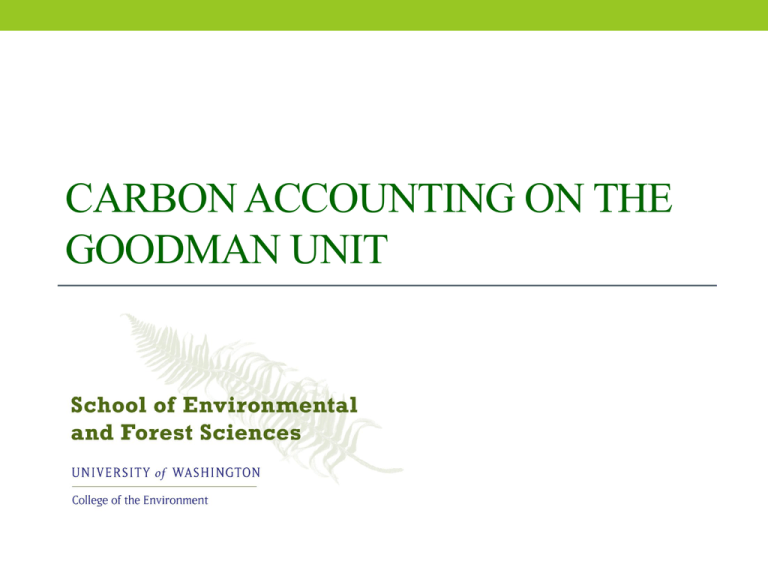
CARBON ACCOUNTING ON THE GOODMAN UNIT OVERVIEW Goodman unit area: ~7,700 hectares 1. Alternatives of Goodman Unit Management Total Carbon: 1.9 million tonnes of Carbon 2. Carbon Calculations 6 million mega grams of CO2 equivalence 3. Carbon Certification 4. Wood Buildings ALTERNATIVES OF GOODMAN UNIT MANAGEMENT Hyunju Lee & Luyi Li Management Scenarios: 1. Baseline 2. No Management 3. Sustainable Forest Management 1. Baseline • How much area: 1.5% of Goodman Unit • How often: Every 5 years • Treatment: Clear-cut, leave 8 (of the largest) tree/acre • Total rotation years: 375 years • Example: Clear-cut 1.5% of Goodman Unit re-harvest the same stand in the year 2394 Stand Visualization of Baseline Management, Stand: 21153 2014 2024 2034 2044 2. No Management Advantages: • Maximize current carbon • No costs for plans or managements Disadvantages: • No timber value • Risk of wind damage Stand Visualization of No Management, Stand: 21153 2014 2024 2034 2044 3. Sustainable Forest Management • How much area: 17% of the Goodman forests • How often (interval): Harvest 5-yr, PCT 10-yr • Which way: - Harvest 70%, Retain 30% - Re-plant 300 Douglas fir seedlings/acre - Pre-commercial thin in 10 years from harvest (e.g. 1st PCT 2024- 1*10 = 2014, 2nd 2034 - 2*10 = 2024) *Increased investment as intensive treatment involved. PCT = Pre-commercial Thin Stand Visualization of Sustainable Forest Management, Stand: 21153 2014 2024 2034 2044 CARBON CALCULATIONS Shannon A. Armitage & Brooke Cassell Carbon Calculations Landscape Management System (LMS) • Developed by University of Washington • Simulates forest growth under forest management prescriptions Carbon Calculations Landscape Management System (LMS) • 10% Random Sample (41 stands out of 411) Carbon Calculations Landscape Management System (LMS) • 10% Random Sample (41 stands out of 411) • Ran many types of simulations and settled on three realistic possibilities Carbon Calculations Landscape Management System (LMS) • 10% Random Sample (41 stands out of 411) • Ran many types of simulations and settled on three realistic possibilities • Projected forest growth for 30 years, which should prevent too much error from the model Carbon Calculations Landscape Management System (LMS) • 10% Random Sample (41 stands out of 411) • Ran many types of simulations and settled on three realistic possibilities • Projected forest growth for 30 years, which should prevent too much error from the model • Multiply by 10 for total unit carbon Carbon Calculations Excel-based Carbon Calculator • (Browne, J.E. 1962) • (U.S. Forest Products Laboratory, 1974) • (Gholz, H.L. et al., 1979) Carbon computed for trees only • Stems • Roots • Branches • Foliage Not including soil or understory vegetation To get our baseline carbon... ACTUAL DATA: SIMULATED DATA: • 411 plots • 41 plots (10%) • 1,922 acres (10.2%) • 18,862.79 acres • 2004 ~ 277.77 acres clear cut (1.5%) • 2009 ~ 270 acres clear cut (1.4%) • 2004 ~ 29.12 acres clear cut (1.5%) • 2009 ~ 27.41 acres clear cut (1.4%) Then we simulated growth to 2014 Where are we now? • 2009: 5,355,371 metric tons CO2e • 2014: 6,140,677 metric tons CO2e Annual Uptake Rate 157,061 Mg CO2e / year Annual CO2e Uptake 180,000 160,000 CO2e (Mg) 140,000 120,000 100,000 80,000 Baseline Harvest 60,000 No Management 40,000 Sustainable Harvest 20,000 0 2009 2014 2019 2024 Years 2029 2034 2039 Total CO2e in the Goodman Unit 12,000,000 CO2e (Mg) 10,000,000 8,000,000 6,000,000 Baseline Harvest 4,000,000 No Management Sustainable Harvest 2,000,000 0 2009 2014 2019 2024 Years 2029 2034 2039 30 year Management Scenarios 2009 - 2039 Management Scenario Average Annual Carbon Uptake (Mg CO2e) Average Annual Timber Revenue Range of Annual Timber Revenue 1. Baseline 127,157 $35,343 $10,500 – $58,000 2. No Management 151,659 $0 $0 3. Sustainable Forest Management 99,646 $28,749 $16,000 - $57,000 A Few Considerations • Our simulations were run on a theoretical, homogeneous landscape based on average conditions across the Goodman Unit. • For truly accurate predictions, each stand will need to have an individual prescription based on its proximity to streams, potential for habitat, etc... • The model does not account for the extensive natural regeneration of western hemlock that occurs on the Olympic Peninsula, so the amount of carbon is likely underestimated. CERTIFICATION Eric Snoozy & Gregg Zimmerman Introduction to 3rd Party Certification To officially claim offsets certification must be obtained • Certification process Carbon Offset vs. Carbon Credit • Parties involved in certification • How to obtain forest certification Certification Standards Several Certification Standards: • Climate Action Reserve • American Carbon Registry • Climate, Community and Biodiversity Standards • Verified Carbon Standard • The Gold Standard Project Types • To obtain certification a “project” must be created • In our case, the “project” would be the Goodman Unit Improved Forest Management • Increases live standing carbon in forest • Employs natural forest management practices. Afforestation, Reforestation, Revegetation • Creating new forests Avoided Conversion • Stopping conversion to • Agriculture • Industrial • From peat swamps Hurdles to Certification on the Goodman Unit • DNR cooperation • Land title or timber rights • Provide management plan(s) that meet requirements for “Natural Forest Management” • Continued monitoring each year (for 100 years) Recommendation: • In order to count the Goodman unit as an offset it must be third party certified. • Our recommendation is to use the Climate Action Reserve certification standard. Although there are challenges to certifying this unit, certification should be considered for claiming offsets consistent with current guidelines. WOOD BUILDINGS Matt Grund & Mikhael Kazzi Why Wood? • Carbon Smart • Energy Efficient • Potentially Costs less • Improves LEED ratings • Efficiently Reused and Recycled Wood is Carbon Smart Requires significantly less energy to manufacture than steel and concrete http://www.corrim.org/pubs/factsheets/fs_05.pdf Stores enough C during lifetime to offset emissions from fossil-fuel intensive concrete Wood is a LEED-er • Building with wood improves LEED ratings • Resource Locality • Renewable Materials • Salvaged/Reusable Materials • Construction Waste Diversion • Low Emitting Materials Energy Efficiency and Cost Bethel School District • All schools built with wood frames • Energy Star rating of 81% • Several schools even achieved 95% - 98% • Wood allows over- insulation • Washington State Code • Steel/Concrete needs thermal break between exterior and interior walls • Thicker walls = More Cost • Wood is exempt!! Cost and Carbon Savings Stadthaus Complex • Costs 15% less than concrete/steel replicate • ¼ the weight of concrete/steel • Lowers transport cost • Built w/ Cross-Laminated Timber • Significantly reduced construction process • Stores even more C than dimensional lumber • Positive C footprint for 20 years! Case Study: Lander Hall • Total Emissions – 24,993 Mg CO2e • Concrete • Steel • Wood 12,375 tons 514 tons 688 tons (550 MBF) • 95% of Lander is concrete Mass of Material in New Lander Hall and steel Wood Concrete + Steel • 5% of Lander is wood Lander Hall Carbon Emissions and Savings naturally:wood* 630 BF (1m3) Dimensional Lumber • Life-Cycle Assessment • PAS 2050 protocol • Full Carbon credit after 100 years Carbon Stored +765 kg CO2e Carbon Emissions (Harvesting, Manufacturing and -185 kg CO2e Transportation) Building Lifespan Carbon Sequestered 50 years +198 kg CO2e 75 years +389 kg CO2e 100 years +580 kg CO2e (75% for 75yrs, 50% for 50yrs) • Lander emits.. • 50yr: 24,993 Mg CO2e • 75yr: 24,826 Mg CO2e • 100yr: 24,440 Mg CO2e • All Wood-Lander offsets.. • 50 yr: +2083 Mg CO2e Lander Hall 550,000 BF Dimensional Lumber** • 75 yr: +5370 Mg CO2e 50 years +173 Mg CO2e • 100yr: +8655 Mg CO2e 75 years 100 years +340 Mg CO2e +506 Mg CO2e *naturally:wood: Demonstrating Wood’s Carbon Benefits, Feb. 2011 **John Gilson of Walsh Construction; Troy Stahlecker of UW Capital Projects Office Lander Emissions and Offsets Projections 0% wood • Lander w/ 50 year lifespan is 90% Lander Emissions wood to = Net Zero Carbon • >90% to achieve offsets • 100 yr Lander w/ 62% wood Mg CO2 Carbon Emissions 50yr Lifespan • Increase Lifespan 75yr Lifespan • Increase C Savings 100yr Lifespan • Less wood for C offsets Current Lander • Increase % Wood 0 10 20 30 40 % Wood 50 60 70 80 90 100 110 • Increase C Savings • Increase offsets in less time Carbon Offsets • Increase Lifespan and % Wood • Largest offsets • Most sustainable Conclusion Goodman unit area: ~7,700 hectares Total Carbon: 1.9 million tonnes of Carbon 6 million mega grams of CO2 equivalence 1. Alternatives of Goodman Unit Management 2. Carbon Calculations 3. Carbon Certification 4. Wood Buildings Annual Goodman Unit Uptake & University Emissions 180000 CO2e (Mg) 150000 120000 90000 +157,000 Mg CO2e -164,500 Mg CO2e 60000 30000 0 Goodman Unit Carbon Sequestration University Emissions To Achieve Carbon Reduction of Building Materials: • Increase Life Span • Use Wood in Buildings Acknowledgements • We would like to thank Dr. David Ford and Dr. Greg Ettl for their assistance with this project • As well as: • STARS • Jeff Cominick • Jason Cross • Guarrin Sakagawa • Dr. Rolf Gersonde • Dr. Elaine Oneil • Dr. Tom DeLuca • Troy Stahlecker • Walsh Construction
